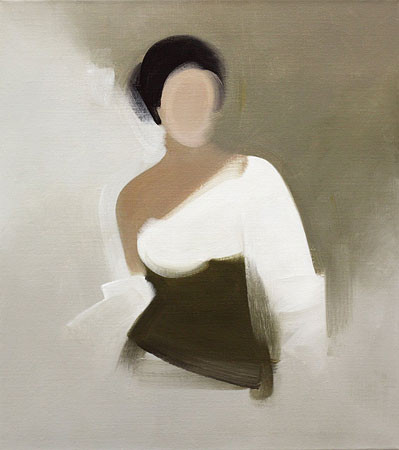Michael van Ofen
20 Feb - 06 Mar 2010
MICHAEL VAN OFEN
February 20th – March 6th 2010
What Painting, and Only Painting, Can Do
by Jens Hoffmann
Michael van Ofen’s paintings take off precisely from a point where painting suffered one of its greatest historical defeats. His inspiration is 19th-century genre painting, a moment when painting was forced to compete with the invention of photography, and then soon afterward with Modernism. Van Ofen performs a dissection of the rational, academic remains of portraiture and landscape painting of that era, exposing the fundamentals of a practice that was about to implode, but which was still free of the encumbrances of reinvention or deconstruction. He mines the defeat of painting, finding within it what he has described as the ideal “found object”. He describes this material as artistically mundane or even awful, yet profanely realistic, photorealistically rendered, with a stable construction founded on traditional skills. Thus a moment of noninvention in art is, ironically, van Ofen’s point of departure for reinvention.
His aprupt shift from photography to painting after art school is perhaps best understood as onceptual gesture; indeed, van Ofen cites as his artistic inspirations artists as Blinky Palermo, Michael Asher, Bruce Nauman, and Marcel Broodthaers—none of them painters. His conscious distancing, even dismissal of his source material, is about as far as one can get from our contemporary, fetishistic conception of the painterly touch. Van Ofen taught himself the skills and techniques of 19th-century painting partly in order to comment upon these very structures and techniques. “I see myself in a long tradition of learning the skills of painting from adapting the results of past painters. As opposed to them, however, I don’t have to travel to Italy to copy Titian like the old Flemish masters did, but can use easily accessible reproductions containing all the necessary information.” Van Ofen’s process of acquiring skills is an arm’s-length approach.
“By following this practice I’ve been continually learning the fundamental structures of the genres and become more autonomous from the sources.” Indeed, for his most recent paintings no specific historical sources exist. The end result is a series that, surprisingly, approaches abstraction, although van Ofen
denies the possibility of an entirely abstract practice for himself. “Some pictures of mine happen to look like abstract works of art. In fact, though, they are just results of a figurative line of development reaching far out into the abstract.”
Van Ofen uses no preparatory drawings or studies; the wet-on-wet style of oil painting allows for a constant and ongoing reevaluation as he works. Of this enduring process he has observed, “Whenever I’m not satisfied with the results on the canvas I can wipe them away and start again on a virgin surface. So, however fierce the struggle was, you can’t see any wounds or scars of its failures and suffered defeats.”
Van Ofen’s gesture is not about returning to convention, but rather revisiting the still-relevant embers of what painting, and only painting, can effect.
February 20th – March 6th 2010
What Painting, and Only Painting, Can Do
by Jens Hoffmann
Michael van Ofen’s paintings take off precisely from a point where painting suffered one of its greatest historical defeats. His inspiration is 19th-century genre painting, a moment when painting was forced to compete with the invention of photography, and then soon afterward with Modernism. Van Ofen performs a dissection of the rational, academic remains of portraiture and landscape painting of that era, exposing the fundamentals of a practice that was about to implode, but which was still free of the encumbrances of reinvention or deconstruction. He mines the defeat of painting, finding within it what he has described as the ideal “found object”. He describes this material as artistically mundane or even awful, yet profanely realistic, photorealistically rendered, with a stable construction founded on traditional skills. Thus a moment of noninvention in art is, ironically, van Ofen’s point of departure for reinvention.
His aprupt shift from photography to painting after art school is perhaps best understood as onceptual gesture; indeed, van Ofen cites as his artistic inspirations artists as Blinky Palermo, Michael Asher, Bruce Nauman, and Marcel Broodthaers—none of them painters. His conscious distancing, even dismissal of his source material, is about as far as one can get from our contemporary, fetishistic conception of the painterly touch. Van Ofen taught himself the skills and techniques of 19th-century painting partly in order to comment upon these very structures and techniques. “I see myself in a long tradition of learning the skills of painting from adapting the results of past painters. As opposed to them, however, I don’t have to travel to Italy to copy Titian like the old Flemish masters did, but can use easily accessible reproductions containing all the necessary information.” Van Ofen’s process of acquiring skills is an arm’s-length approach.
“By following this practice I’ve been continually learning the fundamental structures of the genres and become more autonomous from the sources.” Indeed, for his most recent paintings no specific historical sources exist. The end result is a series that, surprisingly, approaches abstraction, although van Ofen
denies the possibility of an entirely abstract practice for himself. “Some pictures of mine happen to look like abstract works of art. In fact, though, they are just results of a figurative line of development reaching far out into the abstract.”
Van Ofen uses no preparatory drawings or studies; the wet-on-wet style of oil painting allows for a constant and ongoing reevaluation as he works. Of this enduring process he has observed, “Whenever I’m not satisfied with the results on the canvas I can wipe them away and start again on a virgin surface. So, however fierce the struggle was, you can’t see any wounds or scars of its failures and suffered defeats.”
Van Ofen’s gesture is not about returning to convention, but rather revisiting the still-relevant embers of what painting, and only painting, can effect.

